
Most of us are fascinated by Astronomy. Facts and new discoveries in outer space never fail to amaze us. The study of the universe at this scale takes us to the edge of our knowledge where things start getting a little uncertain. Several observations made of galaxies around us and the motion of celestial bodies, and our knowledge of physics have led us to conclude that the universe, as we know and observe, doesn’t simply consist of ordinary matter. A huge portion of space is occupied by an invisible kind of stuff that we don’t fully understand, now called dark matter.
Early History
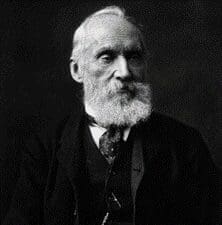


Peculiar as it may sound, the concept of a certain unobservable kind of matter was first proposed by Lord Kelvin (Yes, the same scientist after which the temperature scale is named) back in 1884. Since then, a number of scientists have studied the motion of the celestial bodies at the edges of galaxies, which as per the laws of physics, pointed towards the presence of a huge amount of unseen mass. In early 1930 a Swiss Astrophysicist named Fritz Zwicky followed this line of research and collected a lot of data, leading to the same conclusion. Though, he overestimated the mass of the unseen matter leading to many disbelieving his work, the term he used to define this phenomenon – “Dunkel Materie” (Dark Matter) stuck around.
Later on, in the late 60s and from the 1970s the advent of larger and more advanced telescopes aided the observations of galactic motion to higher accuracies. Two American astronomers, Vera Rubin and Kent Ford made conclusions from such observations which were scientifically more accurate. Thanks to their observation, the presence of Dark Matter was concretized in the Scientific Community.
Not Just the Rotation of Galaxies
It’s not just the anomalous reading of velocity of the outer stars in a galaxy, but many other phenomena which contradict our understanding of theoretical physics unless we consider the presence of extra mass.
Gravitational Lensing: Thanks to the Father of Modern physics, we know that mass has the ability to bend light, or in precise words, to bring a curve to the straight path a ray of light usually follows, just like a lens. The gravitational effects of massive galaxies can be observed in the form of distorted images of certain celestial entities present “behind” the galaxy. Yes, you read it right, the effect of gravity literally bends the light coming from the object, and if the curvature is just about right, we get to observe that ray of light in our telescopes. The amount of curvature is again dependent on the mass of the galaxies. While studying the lensing phenomena and estimating the mass of celestial structures, which again turned out to be more than the observed mass. In simple words, there is something out there, which we cannot see, but its effects are visible.
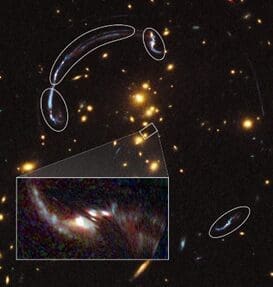
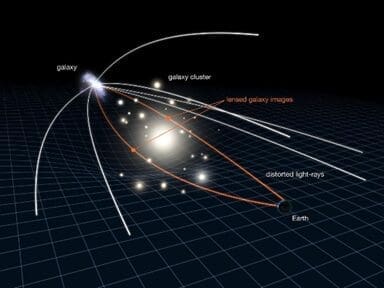
X-Ray Study of Galaxies: Galaxies contain supernovae (remnants of stars that died blasting), which contain hot gases, which emit x-rays. We have come this far in the study of outer space, majorly because we have become quite clever in interpreting the data from the electromagnetic spectrum emitted, absorbed, reflected, and transmitted by various objects in the universe. A study of X-rays emitted by the gas can be used to predict its mass and pressure of it, while doing so, (Yes, you guessed it right, anomaly again), the observed mass and its gravitational effect don’t seem to match our Math.
The existence of Galaxies: Crazy as it may sound, researchers have modeled the formation of our universe using powerful computers, and while doing so many possibilities have been examined by varying the parameters in our existing reality. In a Ted talk given by Richa Wesler, regarding her research on dark matter, said, the formation of galaxies and clusters wouldn’t have been possible at all had there been no dark matter. In this context, dark matter can be considered as a kind of “glue” that binds and holds the stars within a galaxy and galaxies within a cluster close to each other bound together.
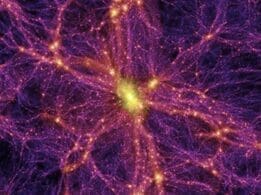
So what is dark matter?
It could be anything that has mass and acts predominantly via gravity. Everything we see around us is made up of such “baryonic matter”. Baryonic, simply refers to protons, electrons, neutrons (the stuff we are made of), and other fundamental particles within the limits of our knowledge and our ability to study them. However, since such particles tend to form massive structures such as stars, galaxies, black holes, and planets like earth, the unseen matter doesn’t seem to collapse into any such entities. In fact, it is theorized that this unknown stuff is spread out around galaxies and clusters.
Thus, the scientific community of today believes in the existence of certain hypothetical particles which have been classified as “non-baryonic”. Universe, as we know, constitutes 5% baryonic and a whopping 27% of dark matter. (The rest is dark energy, a topic for another day). If they are the majority, why can’t we find any direct evidence of them? These particles which are exotic have properties that make them so hard to detect. Many possible candidates have been assumed and conscious efforts are being made today to detect the presence of these hypothetical particles which may constitute dark matter.
Not so Hopeless
If they do not interact with ordinary matter, nor with light, then how do researchers plan to detect them?
Physics and Astronomy are fascinating subjects and they have become even more interesting since the late 20th century. With the development of quantum mechanics and particle physics, we can create “new” particles, and provide explanations of everyday phenomena with very contradicting happenings at the subatomic scale. Assuming, dark matter particles traveling across space, collide with baryonic particles, resulting in fluctuations in energy, these fluctuations can later be detected by very sensitive instruments. These instruments work at cryogenic temperatures (Almost 0 K), located deep underground (How deep? Around a kilometer at least!) which can pick up the faintest of anomalies in the heat signature within the sensors. This is a direct method of detection, but the observation still cannot be confirmed since detectors around the world contradict each other’s readings while many observations are considered false detections.
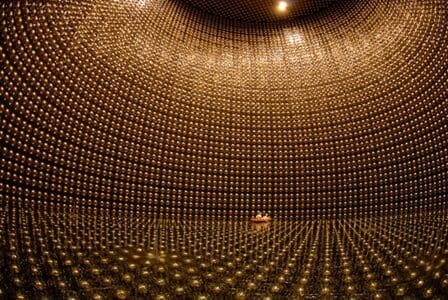
The Large Underground Xenon Experiment (Dark Matter Detector in South Dakota)
Indirectly, dark matter can be detected by again looking out into space. In regions of high dark matter density, the possibility of decay of dark matter particles into the baryonic matter, resulting in the release of high-energy gamma rays, can be searched for. But the problem is differentiating such events from other known cosmological events which give out similar signals.
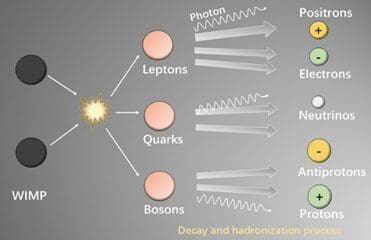
WIMP (Weakly Interacting Massive Particle) – A hypothetical candidate for dark matter has been proposed to decay into the fundamental particles as shown.
Researchers at particle accelerators as well are participating in the race of search for matter exotica. Collisions of high-energy particles result in spectacular things, the formation of new particles, and the disappearance of particles into the light. If such collisions result in the formation of particles and energy less than the amount supplied, it could be an indication of the particles disappearing to form dark matter particles. Such observations must match with other experiments around the world and detectors underground to actually confirm their validity.

The Large Hadron Collider – The most particle accelerator is used at forefront of scientific research in particle and quantum physics.
On a concluding note, we are not just made of star stuff, we are made of unique stuff. Nearly 85% of the matter in-universe is stuff we cannot see. But which large cosmological structures owe their existence. There might or might not be the Force but there surely is dark matter.

Be the first to comment